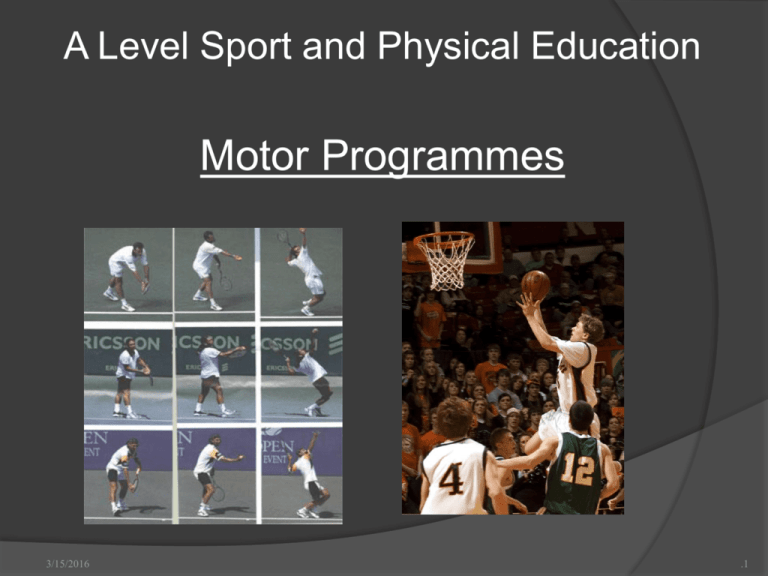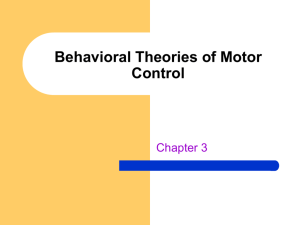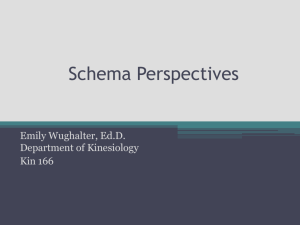Motor Programme Live Show
advertisement

A Level Sport and Physical Education Motor Programmes 3/15/2016 .1 LEARNING OBJECTIVE BY THE END OF THIS CHAPTER YOU SHOULD BE ABLE TO: Understand the make up of a motor programme Describe motor programmes through the use of practical examples Demonstrate How Open and Closed Loop Theory explains how skills are controlled Understand SCHEMA theory and compare it to Open and Closed Loop theory 3/15/2016 .2 MOTOR AND EXECUTIVE PROGRAMMES MOTOR PROGRAMME or EXECUTIVE MOTOR PROGRAMME • • • • • • IS A PLAN of the whole skill or pattern of movement defined as a set of movements stored as a whole in the long-term memory contains all the information required to make a movement : – which muscles to use – the order in which muscles are used – the phasing and degree of contraction of muscles enables a skill to be performed can be made up of a large number of subroutines must be adaptable so that it can be altered when the environment / surroundings change SUBROUTINES • • • • component parts of an executive programme structured in layers – some subroutines can be in turn broken down into further subroutines which form smaller parts of a skill which when fully learned can be performed automatically without conscious control 3/15/2016 .3 MOTOR AND EXECUTIVE PROGRAMMES STRUCTURE OF EXECUTIVE PROGRAMME FOR A DISCUS THROW EXECUTIVE PROGRAMME DISCUS THROW initial stance preliminary swings transition into turn turn power position feet / leg action 3/15/2016 throwing action trunk action recovery SUBROUTINES arm action .4 MOTOR AND EXECUTIVE PROGRAMMES STRUCTURE OF EXECUTIVE PROGRAMME FOR A TENNIS SERVE EXECUTIVE PROGRAMME TENNIS SERVE grip 3/15/2016 stance throw swing weight transfer feet / leg action strike trunk action SUBROUTINES arm action .5 MOTOR CONTROL OPEN LOOP CONTROL • • • • • this applies to executive programmes whose subroutines are simple and well-learned and are automatic (no conscious thought is necessary) they are then completed rapidly without time for feedback and apply to closed and self-paced skills examples : – tennis serve – discus throw MOTOR CONTROL MECHANISM MOVEMENT MOTOR COMMANDS 3/15/2016 .6 MOTOR CONTROL CLOSED LOOP CONTROL • • • • • this applies to ongoing movements in which only part of the information necessary to complete a movement is sent to effector organs (neuromuscular system) the remaining information is sent following feedback via kinaesthesis information about balance and body position can be used to change these factors during a movement examples : – riding a bike – performing a gymnastic move – performing a complex dive KINAESTHETIC FEEDBACK MOTOR CONTROL MECHANISM MOVEMENT MOTOR COMMANDS 3/15/2016 .7 SCHEMA (SCHMIDT’s THEORY) • SCHEMA: IS A BUILD UP OF EXPERIENCES, which can be adapted and used to meet the demands of new situations. • It explains how sports performers can undertake so many actions with very little conscious control • The bigger the schema the more efficient the movement • Large amounts of varied practice are needed to improve a schema • Feedback is very important to correct and update a schema CAN YOU DESCRIBE ANY SCHEMA’S YOU HAVE BUILT UP FOR YOUR SPORT? 3/15/2016 .8 SCHEMA • a schema is the information about : – where the performer is (knowledge of the environment) – what the performer has to do to perform successfully (response specifications) – what a movement feels like (sensory consequences) – what happens when the performer responds (response outcomes) which is stored and used to update a motor programme when used next • RECALL SCHEMA • • • this is all the information needed to start a relevant movement the knowledge of the environment (initial conditions) – playing conditions (pitch, playing surface, weather) – positions of team mates and opposition – condition of equipment (kit, bike, car) the response specifications (the correct technical model) – speed and force required – size and shape of movement required – techniques and styles used 3/15/2016 .9 SCHEMA RECOGNITION SCHEMA • • information needed to correct errors and remember correct performance information about evaluating the response • sensory consequences (knowledge of performance) – the feeling and look of the performance • response outcomes (movement outcomes) – the results of performance – knowledge of results (how far / fast / many) • • used when there is enough time to process feedback or for evaluating performance 3/15/2016 .10







